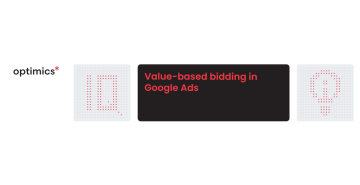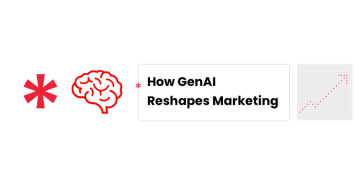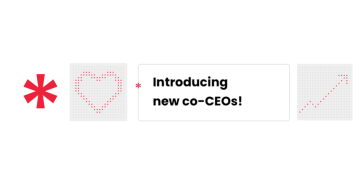
27. 7. 2023
Value-based bidding in Google Ads
What is Value based bidding?
Value based bidding (VBB) enables you to maximise the total value of conversions generated by your Video action campaign. Value bidding comes with two bidding strategies: Max conversion value and target ROAS (tROAS).
With Max Conversion Value, the focus is on obtaining the highest total value from your conversions. This strategy aims to generate the maximum revenue or value from your advertising budget by prioritising conversions with higher estimated values. It automatically adjusts bids to maximise the potential value of each conversion.
On the other hand, tROAS (Target Return on Ad Spend) enables you to set a specific target return on the amount invested in ads. It optimises bids to achieve the desired return on ad spend percentage. By setting a tROAS target, you can ensure that your advertising investments align with your desired return, allowing for efficient allocation of resources.
Both strategies offer a value-centric approach to bidding, considering the worth of each conversion rather than focusing solely on clicks or conversion volume. By adopting VBB and leveraging these bidding strategies, you can make data-driven decisions that maximise the value derived from your Video action campaign.
Value-based bidding benefits
Value-based bidding offers several benefits for optimizing your digital advertising campaigns:
Maximise Value, not just conversions
With value-based bidding, the focus is on maximising the overall value generated by your campaign rather than solely optimizing for conversions. This approach allows you to allocate resources towards higher-value interactions, leading to increased revenue or profitability.
Direct Optimization for sales conversion
Value-based bidding enables you to directly optimize your bids for sales conversion events. Instead of relying solely on clicks or conversion volume, you can prioritise conversions that have a higher value to your business. This ensures that your bidding strategy aligns with your specific sales goals.
Dynamic Bids Based on Conversion Value
Value-based bidding adjusts your bids accordingly if your product feed includes items with varying prices or shopping cart sizes. Each conversion’s bid is optimized based on its estimated value. In this way, resources are allocated more efficiently and accurately.
Tailored Bidding Strategy
Value-based bidding allows you to tailor your bidding strategy to meet your business needs. Conversion types can be valued differently based on their importance or monetary value. This customization ensures that your bids align with your specific goals and priorities.
Improved Efficiency and ROI
By optimizing bids for value, you can enhance the efficiency of your advertising spend. Rather than wasting resources on low-value interactions, value-based bidding allows you to allocate your budget towards interactions that generate the most value. This leads to improved return on investment (ROI) and overall campaign performance.
Adaptability to Competitive Environments
In highly competitive advertising landscapes, costs per click or conversion can fluctuate. Value-based bidding enables you to adjust your bids dynamically based on changing values and competition. This adaptability helps you stay competitive and optimize your ad spend in real-time.
Data-Driven Decision Making
Value-based bidding relies on data and analytics to estimate the value of different conversions. This data-driven approach provides insights into the performance of your campaigns and customer behavior. It enables you to make informed decisions based on actual performance metrics and customer value.
By leveraging value-based bidding, you can optimize your digital advertising campaigns to achieve more value, align with business objectives, and drive higher returns on your ad investments.
When to use value bidding
Value-based bidding is most helpful if various conversions have different value for your business or if you have a specific ROAS target that you’re trying to achieve.
The table below can help you find out which bidding strategy is best for your campaign.
Target ROAS bidding
From July 2023, Google Ads Search campaigns implementing Maximise conversions or Maximise conversion value bid strategies will include target fields. There is a difference between these two bidding strategies in Video Action campaigns. Similar to how Target CPA (cost per action) and Target ROAS (return on ad spend) work, Smart Bidding optimizes your campaigns to achieve these specific goals.
When using Maximise conversions with a defined target CPA, it will optimize your bids to reach the desired cost per action. Maximize conversion value with a set target ROAS will behave similarly to Target ROAS, optimizing bids to achieve the specified return on ad spend.
Please keep in mind that these updates provide advertisers with more flexibility and control over their bidding strategies, allowing them to align their campaigns with specific cost or value targets.
With Google Ads Smart Bidding, this bidding strategy utilizes advanced AI technology to analyze and predict the value of potential conversions when users search for the products or services you advertise. The AI then adjusts your bids for these searches to maximize your return on investment.
In practice, this means that if the bidding strategy determines a user’s search is likely to result in a high-value conversion, Target ROAS will place higher bids on that search. Conversely, if the strategy determines that the search is unlikely to generate a high-value conversion, it will place lower bids. Google’s AI optimizes your bids in real-time for each auction, allowing you to customize bids for every opportunity. For a comprehensive understanding, refer to Your Guide to Smart Bidding.
Target ROAS can be used as a standard strategy for a single campaign or as a portfolio strategy across multiple campaigns. If you are unsure about the suitable portfolio bid strategy for your needs, refer to the information provided in About automated bidding. For those running Shopping campaigns, specific guidance on automated bidding for Shopping campaigns is available.
This article provides an explanation of how Target ROAS bidding operates and provides insights into its various settings.
Target ROAS implementation
In order to implement a Target ROAS bid strategy, you must first set conversion values. Conversion value rules can be applied to accurately represent the value of conversions in relation to your business and optimize towards conversions from more valuable user segments. These rules allow you to apply multiplication factors to conversion values based on factors such as customer types, devices, or locations.
To utilize Target ROAS bidding effectively, most campaign types require a minimum of 15 conversions in the last 30 days. Here are the specific requirements for each campaign type:
Display campaigns
A minimum of 15 conversions with valid conversion values across all your campaigns combined in the past 30 days. New Display campaigns no longer require a history of conversions to use Target ROAS bidding.
App campaigns
At least 10 conversions per day (or 300 conversions in 30 days)
Discovery campaigns
A minimum of 75 conversions in the past 30 days, with at least 10 of those conversions occurring within the past 7 days. Note that Target ROAS is currently in beta for Discovery campaigns.
Video Action Campaigns
At least 30 conversions in the past 30 days.
For Search campaigns, if you have recently started reporting conversion values or made changes to the way conversion values are reported, it is recommended to include the new values in the „Conversions“ column and allow for a 6-week period for your campaign to receive conversion values at a similar rate before adopting the Target ROAS strategy. Additionally, it is advisable to review your budget settings and ensure that you are comfortable spending up to twice your average daily budget.
However, over a month-long billing cycle, you will not be charged more than what your average daily budget would allow for over 30.4 days. For App campaigns, it is also recommended to run a Target Cost Per Action (CPA) campaign type before running a Target ROAS campaign type to establish a baseline ROAS as you set your initial ROAS target. Failing to set an appropriate initial target ROAS may result in poor performance or limited scalability. More about average daily budgets
By fulfilling these requirements and following the recommended practises, you can effectively implement and optimize your campaigns using the Target ROAS bid strategy.
Využijte sílu*
marketingových dat k optimálnímu prodeji
Get in touch
Interested to find out the real potential* of your data?
Drop us your contact details and we will
get back to you shortly.


